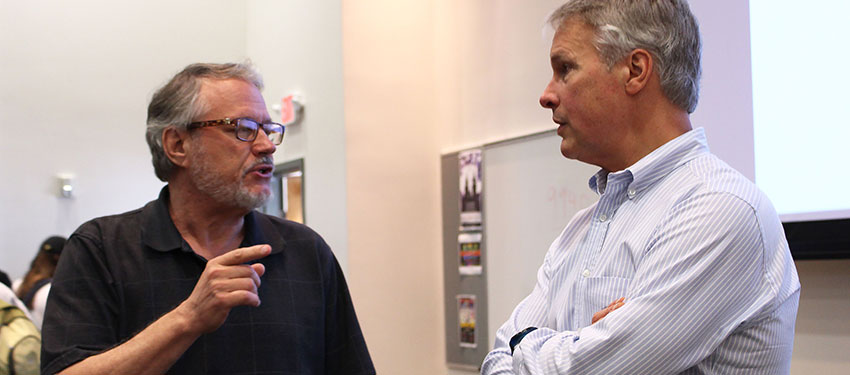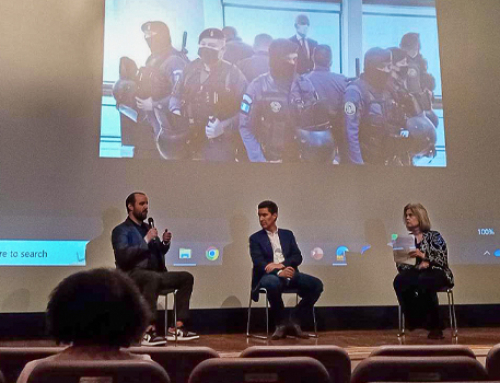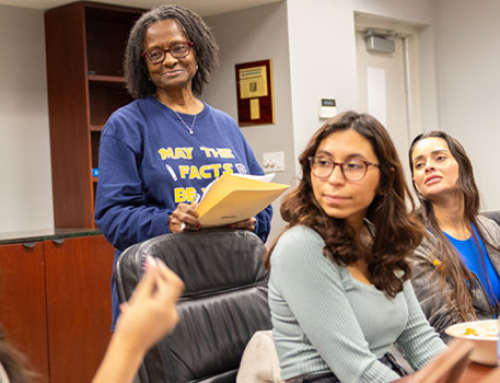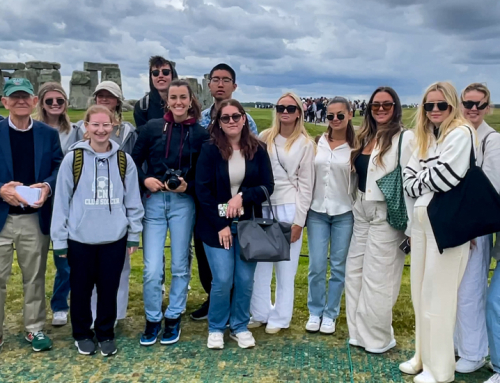By Karina Valdes
The inaugural installment of the James Hoffman Family Endowed Speaker Series was launched in late March with Gary Pruitt, president and CEO of the Associated Press, speaking to journalism students about the First Amendment. Pruitt became president and CEO of the AP in July 2012 after serving as a member of AP’s board of directors since 2003.
Pruitt spoke “about the First Amendment, but not from the usual way.” He told the students his talk wouldn’t concentrate on the law or jurisprudence.
“What I do want to talk about is how the business models, and the technology, and the market place are affecting news media, and how that in turn affects the strength of the First Amendment,” said Pruitt. “To have a robust First Amendment, it needs to be more than journalistically protected,” he added “you need a strong business.”
The AP is a non-profit, 171-year-old news organization that strives for objective, fact-based journalism. Pruitt interlaced the First Amendment and the business of news from the perspective of the AP.
“AP has seen it all in terms of all the media platforms and new technology, and it has had to adjust along the way,” said Pruitt.
The AP’s business model is to license news to other media. Every day the AP generates 2,000 text stories, 4,000 photos, and 150 news videos. AP’s content does not go directly to consumers. Newspapers, magazines, and other media outlets are the customers of the AP, with its journalists gathering news all over the world.
“We are multi-format. Not just text, but audio, photos, and video. Every format,” said Pruitt. “Every day, AP’s content reaches more than half the world’s population.”
The AP was founded in 1846 when an alternative to the cost of sending journalists to cover events was formalized.
“Five newspapers in New York City got together and said ‘we’ve got to find a cheaper way to cover the Mexican-American War. So, let’s pay 20% and hire one reporter to go out to the deserts and cover that war.’ That reporter became the Associated Press,” said Pruitt.
Always adopting the latest technology, in the early days, the AP used the Pony Express to deliver news. The telegraph had been invented, but it was isolated in its usage. AP also owned boats.
“AP had very fast boats in the middle of the 19th century and they would rush out into the Atlantic to meet the ocean-going liners from Europe to get the latest news from Europe and rush back to New York harbor and get it on the telegraph wires before the ocean liners arrived to break the news,” said Pruitt.
Once telegraph lines were installed under the Atlantic, the AP stopped using boats. Back then AP’s only customers were newspapers. Most cities had a dozen, highly partisan newspapers .
“You could always tell the political beliefs and it was a very competitive time. Newspapers weren’t very successful. They often went out of business,” said Pruitt.
At that time, AP introduced non-partisan reporting. There hadn’t been much of that style of reporting before almost anywhere in the world.
“I’d like to say ‘oh, that’s our values, non-partisan reporting.’ It is, but it’s also our business model because we had to sell to all of those newspapers whether they were liberal or conservative,” said Pruitt.
In 1876, the AP lost its first reporter at the Battle of Little Bighorn while covering Custer. Since then, the AP has lost 34 more reporters.
“It’s becoming more dangerous, not less dangerous to be a reporter,” said Pruitt. “You used to have a modicum of protection by having ‘press’ emblazoned on your chest. People thought ‘ok, they’re independent, they tell the news, leave them alone.’ Not anymore. You get targeted for that because extremist groups, terrorist groups, they can go directly to the public through social media and technology. They don’t need the media,” said Pruitt.
Today, reporters do not advertise that they work for the media. According to Pruitt, the murder of a journalist in a war zone should be tried as a war crime, the same way the assassination of medical personnel in a war zone is.
In the 20th century, the rise of radio and television meant advertising shares were taken from newspapers. The advertising pie was getting divided by different media, and a lot of newspapers went out of business.
“Most cities are left then with one newspaper, two at the most, and guess what? That newspaper gets rich because they have a virtual monopoly on the print media,” said Pruitt.
From around 1950 to the early part of last decade was the golden era of newspapers, according to Pruitt. For the AP, it meant a booming business with lots of content sold to radio and television.
The product of the AP is intellectual property, and the company works hard to avoid the stealing and reselling of its content. To highlight this point, Pruitt shared the account of AP photographers landing on the shores of Normandy on D-Day.
During World War II, there was no wireless communication. To meet their deadlines, photographers used carrier pigeons to deliver film canisters back to England to get photos out to the world. Sometimes, the carrier pigeons fell into the hands of French Nazis. How does the AP know that? When ally soldiers would take over parts of Nazi-controlled lands in France, they would find Nazi newspapers with photos crediting AP photojournalists.
“So, I say to our customers that don’t give us credit, the Nazis gave us credit, and they were Nazis,” said Pruitt.
Today, AP has more than 200 bureaus around the world in 108 countries including Tehran, Havana, and Myanmar. It’s the only western news agency with a bureau in North Korea.
“[The North Koreans] don’t censor us in any way and they don’t review our content in any way. They also don’t show their citizens what we report,” said Pruitt.
The North Korean government restricts the news and information its citizens receive. The media is heavily controlled and access to outside sources is prohibited.
“It is a small crack into an incredibly repressive regime,” added Pruitt.
With the emergence of digital media in the 90s, portals like Yahoo and MSN became popular.
“We’ve seen this pattern before. New media emerge, and we get more money, and they get more money, and things get stronger. Something happened. Something changed. In the past decade, it didn’t work out that way,” said Pruitt.
No one is quite sure exactly what happened, but a few things didn’t pan out as they usually do. Newspapers were losing lots of ad revenue, as was radio. TV didn’t lose ad revenue, but it didn’t grow either. Pruitt was expecting local, digital media would grow, replacing the journalists lost at traditional local newspapers. He envisioned powerful, local digital media the same way you have local TV, local radio, and local newspapers. Yet, for some reason, that didn’t happen. There are local websites, but they don’t employ the same number of journalists as in the heyday of newspapers.
“We don’t know what we don’t know. There could be stuff going on [locally] that we don’t even know about,” said Pruitt about the diminishing number of journalists reporting local news.
The economic model of traditional news didn’t support the rise of digital media. A lot of journalists lost their jobs, but weren’t replaced by the new medium that developed.
“Why did the pattern get broken, what’s happening, and what does it mean for you as you think about your future and jobs? Well, I have a few ideas, but if you want to think about this, one of the big trends and forces going on in the news media today, I think it helps to look at the market capitalization of companies,” said Pruitt.
Pruitt then analyzed Apple, Alphabet (owner of Google), Microsoft, Berkshire Hathaway, Amazon, and Facebook, the most valuable companies in the world.
“How do they get 99% of their revenue? Advertising, and that’s never happened before. There’s never been a case where the most valuable companies in the world are getting all their money from advertising,” said Pruitt. “It’s all coming out of the news ecosystem. It’s coming from other media.”
Google used to be one of the AP’s biggest customers. The site would license news and users would be able to see full AP stories on Google. A few years ago, Google decided to stick to being a technology company and, instead of licensing news, it now links to other sites. Google is still a customer of AP’s election services. AP is the only organization that compiles the votes of the 5,000 local, state, and national elections that take place in November. The AP doesn’t tally the votes, but feeds the media 5,000 updates an hour.
A new avenue for AP is fact-checking fake news on Facebook.
“When a story is tagged by users as potentially false, we have a view of the Facebook dashboard, we can pick and choose a story if we wanted, take it on, evaluate it, and debunk it. When we do that, that story has an alert on it that it is potentially false, and has an AP story associated with it that corrects it, or gives the true facts, and it can’t be detached from the story. So, it can still be shared, but it will be shared with a debunking story,” said Pruitt.
This has reduced the number of false stories shared within Facebook.
“We’ve had to diversify and we have. We’re selling our archives more extensively, the photos, the videos, the stylebook, and all that other stuff becomes profitable for us,” said Pruitt.
Today, most of AP’s revenue comes from outside the United States. Pruitt noted the biggest trend in media today is mobile.
“Mobile is the transcendent trend in media for both, the consumption and distribution of news, and, secondarily, is social media again, for both distribution and consumption of news” said Pruitt.
Since mobile is the most prevalent way of consuming news globally, there is a shift in the way consumers expect content.
“Our customers are telling us they want shorter, more visually driven stories with all formats integrated. They used to tell us they wanted text, photos, and videos separate. Now, they want them all together. They want it all story-centric. Just based on the story and they want them shorter because they know they are going to be consumed on mobile,” said Pruitt.
Consumers of news media want easily shareable, visually-driven stories packaged with video, photos, and text.
“What does that mean for journalism students? It means… I think it’ll be a leg-up when you get out if you’re a multi-format journalist,” says Pruitt. “When you start out you will have a leg-up getting a job if you are multi-format because a lot of the older journalists you’ll be competing against aren’t.”
The big advantage for students today is that they are tech-savvy, digital natives.
“You are in a great school for it. You’ve got great facilities. I saw them, they’re expensive, they’re really good. You’ve got a great professor, with a great background in multi-format disciplines, and you’re in a great campus to be global journalists,” said Pruitt.
The James Hoffman Family Endowed Speaker Series is supported by James Hoffman, A.B. ’80, a longtime UM volunteer and past president of the UM Alumni Association’s Denver Alumni Club, to fund an annual lecture on the First Amendment to the U.S. Constitution.






